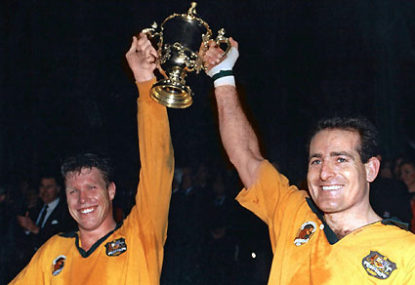While Wallabies coach Robbie Deans anguishes over his squad for Twickenham next weekend, he’d “kill” to have a third of the talent I’m selecting from the crack Wallabies I’ve seen in action since World War 2.
(1) Jon White (1958-65 – 24 caps) – One of the world’s top looseheads in the last 50 years, he was a tower of strength as a scrumagger for the full 80 minutes.
(2) Peter Johnson (1959-72 – 42) – For 13 years, he was the pivot that made the Wallaby pack one of the best in the world. His general play was outstanding; in the thick of the action at all times.
(3) Topo Rodrigues (1984-87 – 26) – Without peer as a tight-head prop who was equally at home in the tight and the loose, as he proved on the Grand Slam tour in 1984.
(4) John Eales (1991-2001 – 86) – Dominated the decade with his all-round brilliance across the park, his captaincy, and his goal-kicking – the complete package.
(5) Rob Heming (1961-67 – 28) – Long before lifting became legal, he could out-jump every opponent, and to prove his point, could effortlessly clap his hands above the cross-bar from a standing start.
(6) Col Windon (1946-52 – 20) – The very first of the mobile flankers, with the speed of a back, and a dynamic defender-forager.
(7) George Smith (2000-09 – 110) – One of the world’s great flankers who never ran out of puff and kept the pressure on every ball-carrier because he was only a sniff away at any stage.
(8) Mark Loane (1973-82 – 28) – A big unit who read the game superbly, was swift to the loose ball, and a bone-crunching defender.
(9) Ken Catchpole (1961-68 – 27) – The greatest half-back in my lifetime by the length of the straight with long bullet passes that thudded into his five-eights middrift with pin-point accuracy, and a superb reader of the game with multiple options at his disposal.
(10) Mark Ella (1980-84 – 25) – The mercurial Mark, the greatest 10 I’ve ever seen, who could find holes in the opposition defences that seemingly weren’t there. The message was clear to trail Ella: those who did were invariably put in the clear. The tragedy is that Catchpole and Ella were a generation apart.
(11) Brendan Moon (1978-86 – 35) – One of the most exciting finishers in the history of rugby, super quick with a deceptive swerve, a side-step, and a powerful fend to match his defence.
(12) Tim Horan (1989-2000 – 80) – The ultimate midfield general. Man of the tournament at the 1999 Rugby World Cup with one sensational performance after another.
(13) Trevor Allan (1946-49 – 14) – Became the Wallabies youngest captain at 21 when Bill McLean broke his leg early on the 1946-47 Wallaby tour. Allan was as devastating in attack as he was in defence, and one of the rare backs to always wear headgear, especially in those days.
(14) David Campese (1982-96 -101) – Famous for his goose step, and the scorer of 64 Test tries, Campo made many of them out of nothing. He was so inventive with dancing feet and an incredible turn of speed.
(15) Dick Tooth (1950-57 – 10) – Medical studies limited his Test appearances, but in every one of the 10 he played he was outstanding with a prodigious boot and rock solid defence. He pioneered arthroscopic surgery and performed the first full knee operation in Australia on none other than Socceroos legend and captain, the late Johnny Warren.
(16) Ewen McKenzie (1990-97 – 51) – An integral member of the Rugby World Cup winning side in 1991, his powerhouse performances for 80 minutes left nothing in the tank. Always an inspirational team-man.
(17) Roy Prosser (1966-72 – 25) – Rightfully rated the best mauler in rugby. Not the fastest around the paddock, he would be last to the maul, and reappear with ball in hand like a thief in the night. An invaluable Wallaby.
(18) Phil Kearns (1989-99 – 62) – A mighty fierce competitor, I always felt sorry for the props who had to lug this huge unit around at scrum time. He was surprisingly fast for his size, and every opponent knew when he tackled them, they stayed tackled.
(19) Steve Cutler (1982-91 – 40) – A string-bean lock, he played well above his weight and was a champion lineout jumper. The possessions he gained on the 1984 Grand Slam tour were instrumental in that success.
(20) Simon Poidevin (1980-91 – 59) – The red-head terrorised the best in the world for just over a decade, tireless for the full journey. His head-to-heads with All Blacks “Cowboy” Shaw and Andy Haden are legendary and bloody.
(21) Nick Farr-Jones (1984-93 – 63) – Right off the top shelf in every department, there were no flaws to his game, and his captaincy to win the 1991 RWC played a huge role in that historic win.
(22) Michael Lynagh (1984-95 – 72) – One of the world’s leading point-scorers, he was equally at home wearing 10 or 12, which made him an invaluable asset to his watch as captain of the men-in-gold.
(23) Jim Lenehan (1956-67 – 24) – What an athlete. In 1955 and 1956 he won the GPS shot putt and hurdles setting new records, the most unlikely of combinations. He left St Ignatious in 1956, and was on the Wallaby tour in 1957 where he showed all the attributes that made him one of the greats as a speedy full-back with a huge boot who tackled as though there was no tomorrow.
That’s it, what a magnificent squad with not a hint of a weakness, and including 14 Wallaby captains – Johnson, Eales, Windon, Smith, Loane, Catchpole, Ella, Horan, Allan, Tooth, Kearns, Poidevin, Lynagh, and Lenehan.





























































































